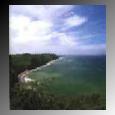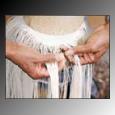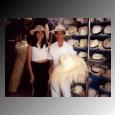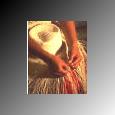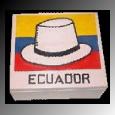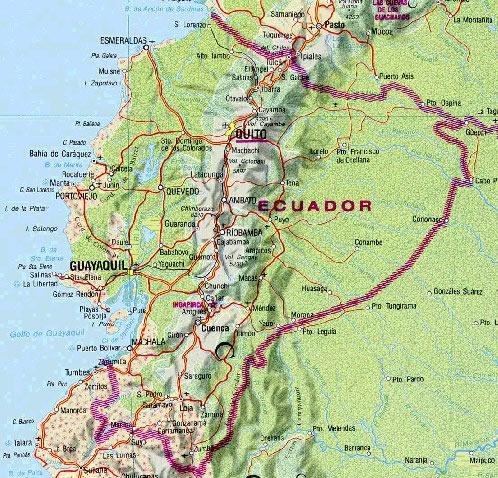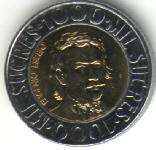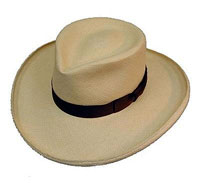|
|---|
 |
 |
|
The panama hats as called nowadays are made out of palm straws (paja toquilla). The name of Panama hat does not come from the place of origin of these hats, which are Ecuador Manabi and Montecristi. There is no way to tell how many products such as the Panama-hat are out there? The controversy of this particular product roots out from its name. In order to present a brief background on this particular, artisan and cultural products it is necessary to explore some of the stories that date approximately 300 years. During the 1700s the main ports of trade for the products (Panama Hats) coming from South America were the ports located in the Isthmus of Panama. Still prior to the construction of the canal, it was a strategic point because of the connection it offers between the Atlantic Ocean and the Pacific and as well to be located in the nexus between South America and the North. In the 1800s, gold seekers from the East picked up some hats on their way to the West, and picked up some of them on their way back to the East Coast. The same thing happened during the construction of the Panama Canal. These hats are fresh and allow air to come in, because they are woven hats, and also do a really good job blocking the sun, which is ideal for workers in Central America where they get plenty of heat and sunshine. The name stuck since than. Later on, this type of hats became well know when heads of states and Hollywood celebrities started to wear them. The Ecuadorian Panama Hats are still hand made by indigenous people in the location of Montecristi in the province of Manabi. The production of these hats has developed and has extended to the city of Cuenca that is a trade center greater than Montecristi. The Ecuadorian Government especially Corporación de Promoción de Exportaciones e Inversiones (CORPEI) is trying to promote these types of artisan work and especially the Panama Hat due to that the hats are hard to imitate in terms of production and it also represents a strong cultural value of the Ecuador. The Embassy of Ecuador has some hats that are in exhibition in the main hall of the Embassy. And there are several articles published very recently about the topic. One of the key issue is to consider the same name of the hat and find out what ahs been done to correct this mistake made for over more than 200 years now and what are the possibilities of changes being made. The trade aspect of this product shows that the products from Ecuador entering US post have been increasing considerably.
Some
of the related cases that were found are the case by Christina Kibler
on Fair-trade The topic is not directly related to the issue of
panama hats and the trade of the same, but talks about the fair
the changing market system caused by the e-commerce and the protection
and adjustment that emerging markets as Ecuador should implement.
The panama hats are no exceptions to this phenomenon. The production
of the hats is somehow protected due to the particular and unique
process, but once the product is finished the commercialization
of the product should adequate to the changing system. |
Coast of Manabi
|
 |
|
There
are no disputes currently undergoing in the WTO for this products.
However the legal aspects of this product can be related to regional
agreements and trade promotion efforts by the government of Ecuador.
The Andean Trade Promotion and Drug Eradication Act (ATPDEA) is
one of the binding agreements between the government of the United
States and the Andean Region which includes Ecuador, Colombia,
Peru and Bolivia. This agreement includes many products and give
to the countries included in the Andean region a access to the
American Market for a considerable number of products. One of
the products included in the ATPDEA is the “Panama Hat”
as long as the exporters of this products comply with regulation
from the FDA, US Customs and USDA the entry of this product to
the US is duty free (no tariff). The government of Ecuador also has made a number of projects to promote the export of Panama Hats. The government entity in charge of those projects is the CORPEI – (Corporación de promociones de exportaciones e inversiones). One of the most recent projects is the “Perfil Del Producto Paja Toquilla” which was made in a combined effort by the CORPEI. Some
of the interesting facts that are mentioned as conclusion after
the research done by the analyst of CORPEI is that the products
is famous and recognized in the world and there are no many sources
other than Ecuadorians for this product. The problem is that Global
Environmental groups have presented serious concerns about the
production of Panama Hats and also the demand for such product
is not increasing. Under the ATPDEA, the treatment of this product
is mentioned to be the same under the NAFTA and most of the products
included in the Andean Agreement are receiving the same treatment
than the product under NAFTA. The
ATPDEA was signed into public law during the current administration
in 2002 as a renewal of the ATPA Andean Trade Preference Act.
The trade regulation of the “Panama Hat” between Ecuador
and its main importer the United States is regulated under these
rules. Under the GSP and the trade relations between EU and Ecuador
87% of the Ecuadorian Exports going into the EU are duty free
(no tariffs) Panama Hat is one of the products included in the
87%. The European Union allows the entry of this products tariff
free. Through the European Commission the EU has been active in
promoting trade relations not only with Ecuador, but also with
most of the Latin American countries and has been of great help
in the promotion of regional integration such as Mercosur and
the Andean Community. |
|
 |
|
The production of the product is mainly located in the province of Manabi in the cities of Montecristi, Jipijapa and Cuenca. Montecrist is more of the center of production and Cuenca, which is more of a trade center for the product. These sites are located in the west coast of the Ecuadorian territory in the borders of the Pacific Ocean. The territory is mostly a dense tropical forest.
The
location in which these hats are produced is ideal in terms of
climate conditions for the straws and the production of the hats.
|
|
 |
Trade data for panama hats (HTS harmonized tariff schedule) for panama hats The trade aspect of the panama hats: Form the production of the same and the commercialization of the product there different points to be mentioned. In the production there three different categories of producers: The small, medium and large producers. A) The small producers can produce from 5 to 8 hats in a month and this are usually single families. B) The medium producers can produce up 100 to 120 hats in six month. C) The large producer can produce up 1000 hats in six month. The value added of the hats is described in the following outline:
3) WEAVERS 4) BROKER The Value of the exported Panama Hats can run to $1000 depending on the quality of the hats. The ones mentioned above are values of medium quality hats that run around $50 to $200 in the U.S. market. Only a 10% of the final product is consumed in Ecuador and %90 is exported. One of the mayor destinations for these hats is the U.S. In the study done by the CORPEI, the Ecuadorian exporters sell the products to the U.S. importer at $90 to $100 in the case of the Ultrafinos de Montecristi is sold to the final consumer in the U.S. for $800 to $1000. Trade
Data |
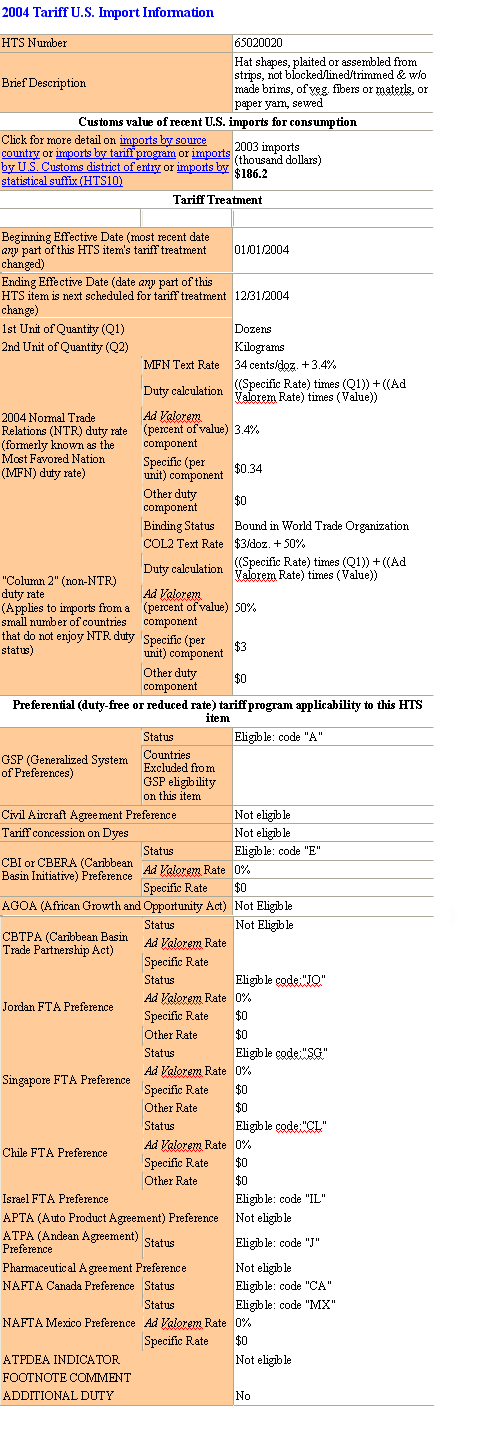 |
The table above explains the different requirements for the Panama Hats to be exported from Ecuador to the United States. Since the product is part of the ATPDEA the entry of these type of product to the United States is considerably done in favorable terms. For countries such as Ecuador that enjoy the APTA agreement with the U.S. market has advantages in exporting these types of products to the U.S. Import restrictions: ECUADOR The
only import restrictions for Ecuador from the US are the three items
posted above. The
FDA is the main entity controlling products imported by the United
States. Their records post restrcitions con products coming into
the United States. |
|
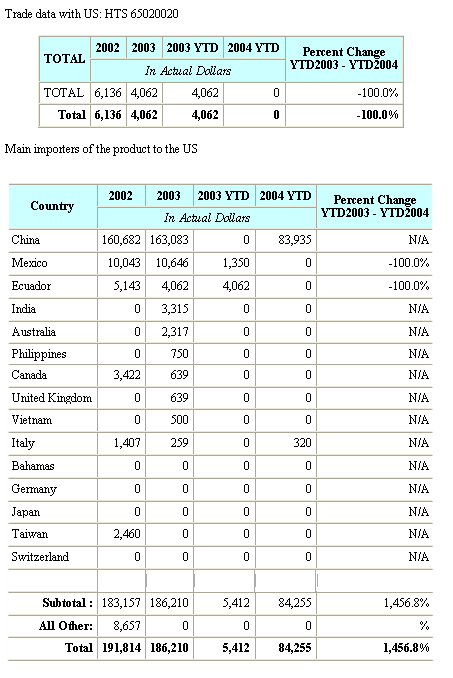 |
|
The above table show the main exporters of similar type of product
to the United States. Since the Panama Hat does not have its own
HTS code the imports from countries such as China and Mexico that
produce a similar type of products are recorded as well. The particular
products such as Panama Hats are included in these records.
|

|
The
article written by Mr. Brent Black a journalist and Panama specialist
in the United States gives us a brief description of the cultural
meaning and the historical value of these hats. Ecuador is one of
the countries that still present a large percentage of indigenous
population. It is said that Ecuador has approximately 60% of their
population classified as indigenous. In countries like Argentina
where the composition of the ethnic diversity is mainly by Europeans
origins is hard to find Argentinean people feeling identified by
there cultural roots relating to Native Americans. On the other
hand, Ecuador is an example of indigenous people being still a large
part of a modern nation. They have considerable participation in
the political, social and cultural aspects of Ecuador. This is one
of the reasons which make the Ecuadorian people to feel deeply related
to their indigenous roots and panama hats in one of the cases. The province of Manabi is the region more suitable for the plantation of toquilla. The environmental side effect seems to be minimal due to that in this region people have plantations of these plants and they are not part of the natural ecosystem (wild life). In terms of the trade issue most of the artisan works in Ecuador are protected by an agency called CAMARI which at the same time is a dependent organization of the FEPP (Popular Ecuadorian Progress Fund). CAMARI has a program of fair trade which educates and allows fair trading conditions and terms for the indigenous people, to protect them from unfair trading practices imposed by large distributors of this product. |
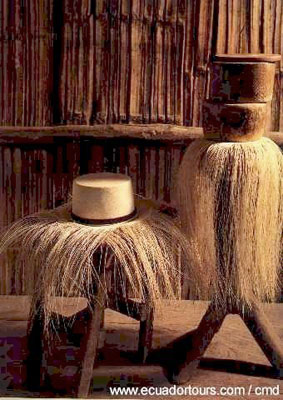 |
 |
The
Ecuadorian Government has made a great deal of effort in coordination
with CORPEI to promote this product. The assessments made in the
50 page document prepared by CORPEI to include this product as part
of the expansion of the export options of Ecuador show a more in
depth analysis of the product in terms of production, trade, and
opportunities. The possibilities that this product can offer is considerably large compare to the environmental and labor risk that it poses. The profits of selling the hats are relatively larger than the cost compared to other products. The influential factor is the fact that this is an artisan product and the name that this product has gain in the international market. |
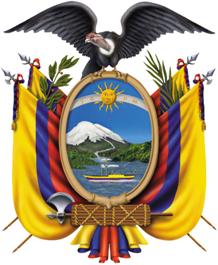 |
| Back to Top |
| All rights reserved. 2004 Hwon Bum Pak American University SIS 513-01 |




